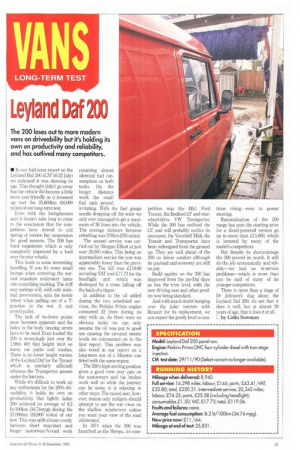VANS
Page 57

If you've noticed an error in this article please click here to report it so we can fix it.
LONG-TERM TEST
Leyland Ir 253
The 200 loses out to more modern vans on driveability but it's holding its own on productivity and reliability, and has outlived many competitors.
• In our half-term report on the Leyland Daf 200 (CM 16-22 July) we reckoned it was showing its age. This thought didn't go away but the vehicle did become a little more user-friendly as it loosened up over the 25,600km (16,000 miles) of our long-term test.
Even with the Isringhausen seat it doesn't take long to come to the conclusion that the competitors have moved to coil spring or torsion bar suspension for good reasons. The 200 has hard suspension which is only marginally improved by a load over the rear wheels.
This leads to some interesting handling. If you hit some small bumps when cornering the normal mundane understeer turns into something exciting. The stiff rear springs will, with only minimal provocation, spin the inside wheel when pulling out of a Tjunction in the wet. A real crowd-puller.
The lack of tie-down points soon becomes apparent and the holes in the body bracing struts have to be used. Even loaded the 200 is annoyingly just over the 1.98m (6ft 6in) height limit on many car parks and washes. There is no lower height version of the Leyland Daf (or the Transit which is similarly afflicted) whereas the Transporter passes under the barriers.
While it's difficult to work up any enthusiasm for the 200's driveability, it holds its own on productivity. Our lightly laden 200 achieved an average of 8.2 lit/100km (34.74mpg) during the 27,000km (16,900 miles) of our test. This was split almost evenly between short stop/start and longer motorway/A-road work returning almost identical fuel consumption on both tasks. On the longer distance work the small fuel tank proved irritating. With the fuel gauge needle dropping off the scale we only ever managed to get a maximum of 38 litres into the vehicle. The average distance between refuelling was 376km (235 miles).
The second service was carried out by Morgan Elliott at just over 20,000 miles. This being an intermediate service the cost was appreciably lower than the previous one. The bill was £119.06 including VAT and £17.72 for the headlight unit which was destroyed by a stone falling off the back of a tipper.
In addition to the oil added during the two scheduled services, the Perkins Prima engine consumed 22 litres during its stay with us. As there were no obvious leaks we can only assume the oil was put to good use causing the elevated smoke levels we commented on in the first report. This problem was also noted in our report on a long-term test of a Maestro van fitted with the same engine.
The 200's high seating position gives a good view over cars on the motorways and the brakes work well so while the journey can be noisy, it is relaxing in other ways. The raised seat, however, means only midgets should attempt to use the sun visor on the shallow windscreen unless you want your view of the road obliterated.
In 1974 when the 200 was launched as the Sherpa, its corn
petition was the Mkl Ford Transit, the Bedford CF and rearwheel-drive VW Transporter. While the 200 has outlived the CF, and will probably outlive its successor, the Vauxhall Midi, the Transit and Transporter have been redesigned from the ground up. They are well ahead of the 200 on driver comfort although its payload and economy are still on par.
Build quality on the 200 has improved from the pre-Daf days as has the trim level, with the new driving seat and other goodies now being standard.
And with much doubt hanging over the joint venture with Renault for its replacement, we can expect the goody level to con
tinue rising—even to power steering.
Rationalisation of the 200 range has seen the starting price for a diesel-powered version go up to more than £11,000, which is bettered by many of the model's competitors.
But despite its shortcomings the 200 proved its worth. It will do the job economically and reliably—we had no in-service problems—which is more than can be said of many of its younger competitors
There is more than a tinge of Dr Johnson's dog about the Leyland Daf 200: it's not that it does it well, but at almost 20 years of age, that it does it at all.
by Cohn Sowman
























































































